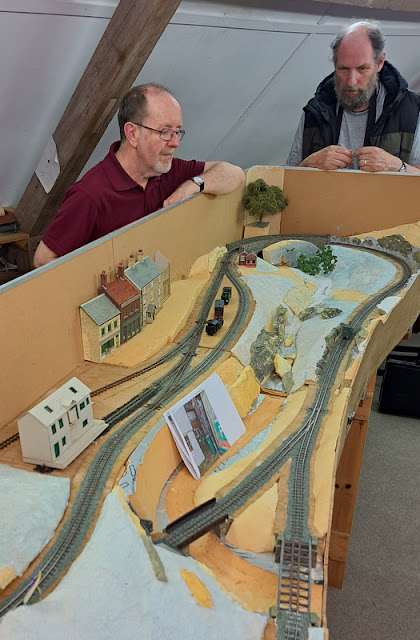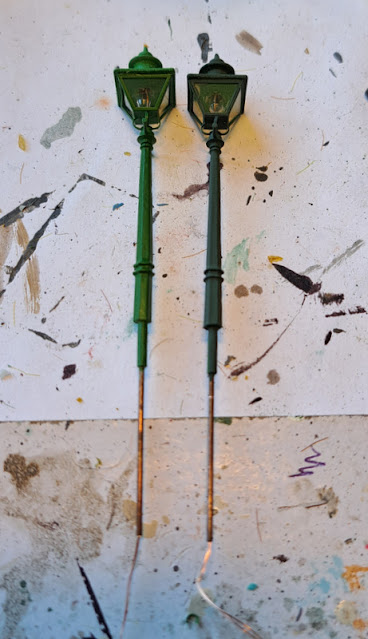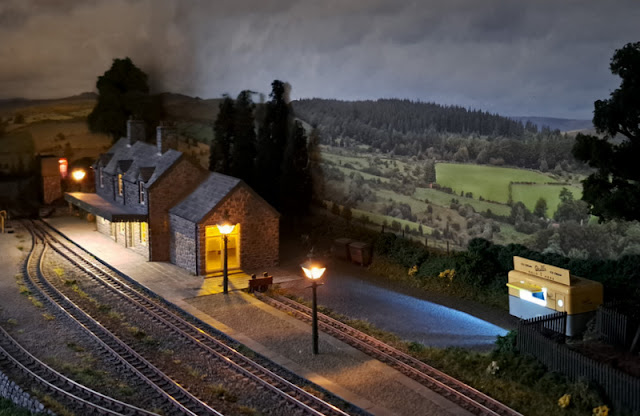The Sussex Downs group recently passed on most of the Upsands Downs and Everleight Railway to a new owner, including some of the venerable hand-held controllers. It was observed that we could do with some new controllers to ensure we have sufficient for the new layout, and perhaps to give better performance. However, the choice isn't clear, with increasing ready-to-run options and modern N-gauge chassis being used with small modern motors, and many of them using coreless motors, as well as models using traditional motors, any new controller has to be able to deal with a wide range of mechanisms. So, I took along my collection of controllers to try out.
Here's the under construction club layout which allows a continuous run, but has 12-inch radius curves on 1 in 30 gradients, so makes a reasonably demanding test track.
Some of the locos used included a modern RTR Bachmann (the Baldwin), an old US N-gauge Bachmann "Brick" Plymouth chassis (under the tram loco), a Fleischmann Picolo (under the green tank), and the ancient Minitrix 0-6-0 (under the saddle tank). We also tested a Backwoods Darjeeling loco, which I think has a Mashima motor, and a Conway Castle using the newest Kato 110 chassis with a coreless motor. I think the Baldwin may also use a coreless, the rest are traditional motor types and some are quite crude by today's standards. We ran the locos alone, without a train, in this quick test.
The subject of suitable controllers for coreless motors is often met with some confusion and potentially misleading information, even by loco and controller manufacturers, who usually state "feedback controllers are not suitable for coreless motors". I'm no expert so have tried to understand it through reading, and the answer really is not that simple. The key points as I see it are:
- Feedback and pulsed controllers are not (quite) the same thing. A pulse controller may not have feedback, but a feedback controller is usually a pulsed type (as it monitors the back EMF "feedback" between pulses).
- The main coreless motor concern is overheating, since there's no iron core to dissapate heat, and the resin bonding the coils can (in theory) be damaged. Smaller "cored" motors can also be affected. Pulsed controllers are more prone to heating (than pure variable DC), and this is not limited to feedback controllers. An old non-feedback controller with a pulsed output (H&M Clipper?) could be damaging, while some feedback types are not - depending on the heating effect of the pulses.
- The other potential issue is that the feedback is not tuned to the low-inertia of coreless motors (or even small, low-inertia cored motors) leading to surging or jerky running. This is related feedback controllers only, and depends on the controller and the motor. This is why some controllers have switched feedback.
So, pulsed controllers are bad right? Well, the problem is pulsed controll (or PWM) is the best way to regulate motors. Giving full voltage overcomes the "stiction" (friction, magnetic resistance/cogging) in the motor, and in our case, any resistance in the pickup/wheel/rail interface, gear train friction, variable friction from motion, etc... so pulsed control allows for fine control at low speeds. DCC chips use pulsed control, as do most motor drives in other applications.
So, how to have pulsed control without overheating? So far as I can tell, the factors are...
- Peak voltage - some controllers actually peak at 16V or more!
- Frequency - most controllers operate at 100Hz (rectified AC). Higher frequencies reduce heating apparently, but can cause noise. DCC chips operate at >20kHz (beyond the range of human hearing, does it bother dogs?). (I tried a Minitrains controller once which also operated at 20kHz, but it didn't seem to work well/smoothly with any motors except Minitrains - I don't know why)
- Pulse shape - for reasons of complex physics I don't really follow, the sharper or more "peaky" the wave-form, the more heating is induced
So, coreless-friendly controllers aim to address one or more of these issues. For those who are interested, reading for more details:
Of course the club layouts use a different plug and wiring standard to my own layouts, so the first job was to make up an adaptor! Not very neat but it did the job.

Gaugemaster W - pure DC control, rectified with variable voltage, which minimises motor heating.
In our tests it works well enough with all motors, giving smooth running, but lacks reliable low-speed control. Locos could sometimes start with a jerk or stop abruptly, with no pulses to keep the motor kicking over, and some motors don't maintain a steady speed - they had to be "driven".
The case is a little bulky and I don't like the slide switch as it's not kind to thumbs (horrible for shunting).
This is a good, safe controller for coreless and smaller motors, and is ideal for continuous runs, but not in my view the best choice for low speeds such as shunting.
(Gaugemaster used to also offer the HH - a traditional feedback pulsed controller. It had a very peaky high-peak voltage waveform which offered good low speed running for older motors, but really heats them up. Not suitable for coreless then... in fact, they don't sell it any more. I had one in my early days of 009 modelling, but sold it when I got AMR controllers.)


KPC - This is a pulsed feedback controller, but with a less peaky waveform and lower peak voltage than the HH. Mine is a "fine-control" model with switched feedback, and seems much kinder to motors than the HH used to be. I've used mine with coreless motors (feedback switched off/down - not sure if it is actually off or just reduced) and they seem to run fine, although my layouts don't exactly allow sustained running. I presume the switch just stops (or reduces) the feed-back regulation of voltage (or pulse width) in response to the back-EMF so it doesn't over-react to coreless motors with low inertia - the output is still pulsed so there may be some risk of motor heating.
In our tests it gave excellent smooth control, including low speed and starting and stopping, thanks to its pulsed output. Locos maintained a steady speed. With feedback on locos run more slowly but some coreless motors surged or vary speed, switching the feedback off worked with all motors. My other KPC has a broken feedback switch, so I have left it in the "off" position.
The slim case and toggle switch mean it fits neatly in the hand and is nice to use single-handed for shunting.
This is my favourite all-round controller, although probably not advisable to use it for sustained running of coreless motors just in case. Sadly no longer available*, it is surprising (and telling) how many exhibition layouts I notice are using KPC controllers!

AMR - This is a also pulsed feedback controller. Some years ago I saw several controllers compared with an oscilloscope, and the AMR and the similar
Trax controller (which I don't have) have a very similar output to the KPC (with feedback on), and with similar characteristics. Interestingly, Nigel Lawton recommends one as being suited to the coreless motors he sells (
http://www.nigellawton009.com/TraxFC1.html), alhough Trax themselves say it is not suited to coreless motors! In reality, I reckon that like the KPC, the AMR and Trax would be fine to use with coreless motors for short periods as Nigel says, but sustained low speed running may cause motor heating.
Since the behaviour is generally similar to the KPC (good low speed control and steady speed) but without the feedback switch, we didn't do extensive tests at the club.
It has really nice ergonomics with it's dinky case and toggle switch for easy shunting and one handed operation. Sadly long out of production, although the similar (in size and performance) Trax is available.

Fidelity - this is a rare one, hand-made in New Zealand! As I understand it, the pulsed output varies in amplitude as well as pulse width and has a waveform designed to minimise heating, to be suitable for cored and coreless motors. It does use feedback, I'm not sure the technicalities but it's more advanced than traditional controllers. It was also available with simulation (inertia and braking) but mine does not have this.
In our tests it worked very well with good low speed control and speed control. It was at least as good as the KPC, and of course is safe for all motors without needing to switch anything.
The case is large and clumsy, and while it has a toggle direction switch it isn't really possible to use one-handed.
So perhaps the ideal controller - the only real issue apart from the ergonomics is that it too is no longer available!
Conclusion? Well, the W is a safe option for all motors, but a feedback pulsed controller (of which the Trax is the only one currently available) gives better low-speed control albeit with the possible risk of overheating coreless motors. The ideal would be a Fidelity in a smaller more ergonomic case! I'd settle for the KPC being available again*. With the range and complexity of DCC systems now on the market and considering what must be possible with modern electronics, it is surprising no manufacturers have looked again at the analogue controller market.
*I'm aware All Components are listing a KPC-like controller, I believe using the original KPC circuitry, but there's little information and they don't list the fine-control switched-feedback model.


















